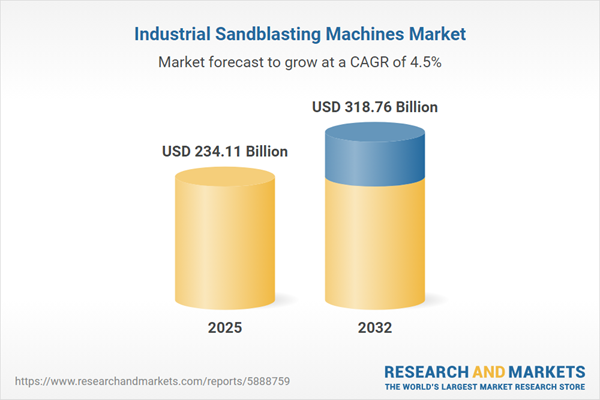Speak directly to the analyst to clarify any post sales queries you may have.
Industrial sandblasting machines are central to evolving manufacturing strategies, supporting process control, regulatory alignment, and efficient supply chain management. As senior decision-makers face increased complexity and operational demands, advanced sandblasting systems present viable solutions for securing consistent performance and future-ready operations.
Market Snapshot: Growth of the Industrial Sandblasting Machines Market
The industrial sandblasting machines market is demonstrating steady expansion, valued at USD 223.98 billion in 2024 and on track to reach USD 234.11 billion by 2025. Forecasts suggest long-term growth, with projections up to USD 318.76 billion by 2032, supported by a compound annual growth rate of 4.50%. Core market drivers include a strong push toward automated and digitally controlled systems, as well as a shift to more sustainable production practices. Industry focus is increasing on advanced surface preparation across sectors, positioning manufacturers of next-generation equipment to address compliance needs and adjust to changing customer expectations as regulations and technology progress.
Scope & Segmentation of the Industrial Sandblasting Machines Market
- Product Types: Automated sandblasting systems, blast rooms designed for large-scale applications, compact enclosed cabinets, and portable sandblasters enable both high-volume output and project-specific mobility.
- End Users: Sectors such as aerospace, automotive, construction, oil and gas, shipbuilding, and general manufacturing drive custom solutions for surface finishing and compliance, shaping the technology decisions manufacturers make.
- Operation Modes: Automation is enabled through CNC, PLC, and robot-assisted units for high precision, while manual and semi-automatic machines provide flexibility for specific projects.
- Abrasive Types: Aluminum oxide, steel grit, garnet, and glass beads are utilized to align with distinct operational goals, with an added focus on sustainability through improved recyclability and lower environmental impact.
- Power Sources: Electric (AC/DC), hydraulic, and pneumatic power, including piston and rotary screw compressors, are used to meet diverse operational needs in various industrial settings.
- Applications: Surface cleaning, deburring, etching, paint and rust removal, and comprehensive surface preparation help improve durability and underpin product quality across workflows.
- Regions: The market reflects differing levels of adoption and supplier selection in the Americas, Europe, Middle East & Africa, and Asia-Pacific, due to regional compliance standards and infrastructure investments.
- Representative Players: Key industry players include Graco Inc., Atlas Copco AB, Nordson Corporation, Sinto Co., Ltd., Clemco Industries Corp., Gema Switzerland GmbH, Wagner Group GmbH & Co. KG, Empire Abrasive Equipment, Sames Kremlin SAS, and Airblast Limited, each addressing specific compliance and sector requirements.
Key Takeaways for Senior Decision-Makers
- Deployment of programmable and digital control systems in industrial sandblasting machines improves overall process consistency and supports transparent asset management, bolstering traceability initiatives.
- Closed-loop and data-driven system adoption leads to greater production stability, enabling ongoing performance gains and stronger risk mitigation.
- Use of reusable, low-waste abrasives strengthens environmentally responsible practices and influences progressive procurement policies.
- Implementation of predictive maintenance along with comprehensive servicing programs optimizes uptime and reliability, resulting in more streamlined operations.
- Adapting to shifting regional regulations and advancing technologies encourages robust compliance strategies and sustainable, future-oriented investments.
Tariff Impact: Navigating U.S. Trade Policy Changes
Recent U.S. tariff adjustments affecting sandblasting machines and abrasive materials are reshaping sourcing and procurement strategies. This especially impacts smaller and mid-sized enterprises balancing both domestic and global supplier networks. By strategically partnering with both local and international suppliers, organizations can mitigate volatility and buffer against tariff exposures. In dynamic markets like Eastern Europe and Latin America, favorable policy frameworks and enhanced technical capabilities are fostering new procurement relationships and supporting supply chain stability.
Methodology & Data Sources
This analysis integrates quantitative and qualitative market data, including regulatory review and insights directly from senior executives, operations leaders, and procurement specialists. Findings reflect current industry goals and leadership perspectives relevant to procurement and technology selection.
Why This Report Matters
- Delivers actionable recommendations based on up-to-date market trends, technology innovations, and sustainability priorities that drive procurement and operational decisions.
- Enables more effective cost control and operational efficiency through guidance on technology integration and supplier management in the industrial sandblasting machines market.
- Clarifies how regulatory trends and evolving supply chain dynamics impact strategic sourcing, supporting agility and resilience in leadership decision-making.
Conclusion
Integrating advanced sandblasting equipment with resilient procurement and compliance strategies positions organizations to maintain manufacturing reliability and effectively address evolving regulatory and operational demands.
Additional Product Information:
- Purchase of this report includes 1 year online access with quarterly updates.
- This report can be updated on request. Please contact our Customer Experience team using the Ask a Question widget on our website.
Table of Contents
3. Executive Summary
4. Market Overview
7. Cumulative Impact of Artificial Intelligence 2025
Companies Mentioned
The companies profiled in this Industrial Sandblasting Machines market report include:- Graco Inc.
- Atlas Copco AB
- Nordson Corporation
- Sinto Co., Ltd.
- Clemco Industries Corp.
- Gema Switzerland GmbH
- Wagner Group GmbH & Co. KG
- Empire Abrasive Equipment, Inc.
- Sames Kremlin SAS
- Airblast Limited
Table Information
| Report Attribute | Details |
|---|---|
| No. of Pages | 183 |
| Published | October 2025 |
| Forecast Period | 2025 - 2032 |
| Estimated Market Value ( USD | $ 234.11 Billion |
| Forecasted Market Value ( USD | $ 318.76 Billion |
| Compound Annual Growth Rate | 4.5% |
| Regions Covered | Global |
| No. of Companies Mentioned | 11 |









